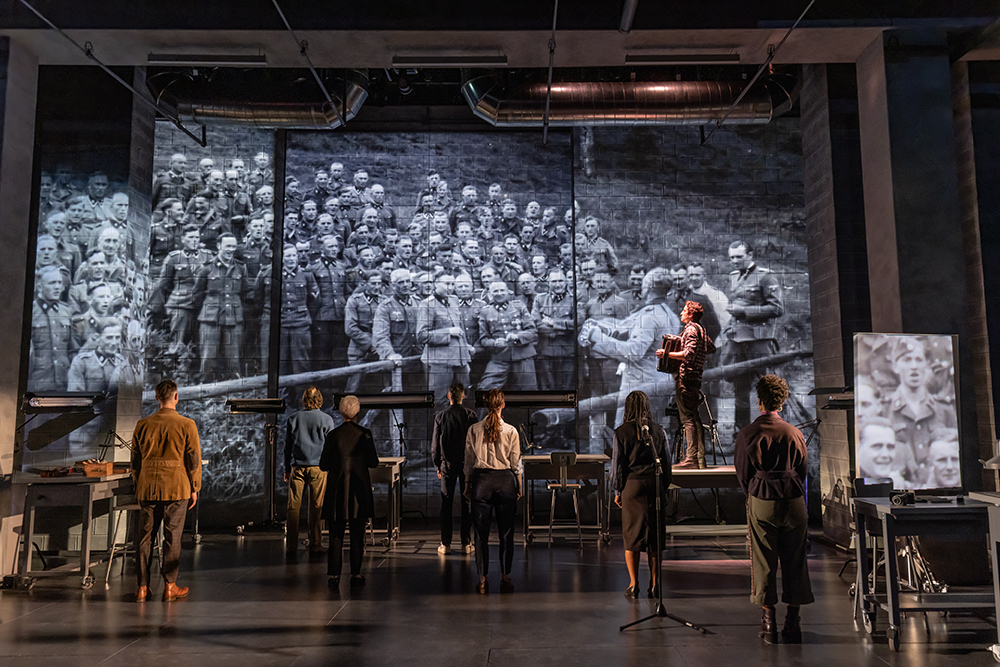“Here There Are Blueberries” Leaves Audiences with Profound Questions
“SELFIES” FROM A SHOCKING SOURCE: The 2007 discovery of a photo album depicting workers from the Auschwitz concentration camp enjoying picnics and gatherings on their days off is the basis of a play opening at McCarter Theatre on Friday, January 24. (Photo by Matthew Murphy)
By Anne Levin
At performances of the play Here There Are Blueberries at McCarter Theatre January 24-February 9, panelists taking part in post-show discussions are as key to the experience as the actors cast in the play.
The drama/detective story by Tectonic Theater Project director Moisés Kaufman and Amanda Gronich, inspired by an album of Nazi-era photographs, poses profound questions about ethical issues and human nature. Audiences at past productions by the La Jolla Playhouse and Shakespeare Theatre Company (McCarter’s production kicks off a national tour) have been reluctant to leave their seats once the play comes to an end.
“We have found, over and over, that the people wanted to stay and talk about what they had just seen,” said Kaufman. “They need to process it. That’s why we have the talkbacks.”
The post-show conversations will follow matinees on January 26 and February 1, 2, and 8. They are part of McCarter’s Arts & Ideas program. Panelists will include Consul General Till Knom of the German Consulate in New York; Rabbi Gil Steinlauf of the Center for Jewish Life at Princeton University; Princeton Professor Elizabeth Levy Paluck; Princeton Theological Seminary President Jonathan Lee Walton; Princeton University Professor Jill Dolan; and U.S. Holocaust Memorial Museum historian Rebecca Erbelding.
Here There Are Blueberries concerns a mysterious photo album that showed up on the desk of an archivist at the U.S. Holocaust Memorial Museum in 2007. Its pages are filled with scenes from the Auschwitz concentration camp — not of the horrific suffering among prisoners; rather of smiling young workers in uniform, relaxing together during their time off.
The photos are, in a sense, selfies from another era. The laughing young people link arms, dance, and interact. They eat dishes of fresh blueberries. One plays an accordion as others look on, clearly enjoying themselves. Then, presumably, they go back to work and carry out unthinkable things.
“This play explores incredibly profound questions,” said Gronich. “We are engaging the audience in a deep reckoning, exploring the issues of culpability, complacency, and complicity through this historical artifact. It raises serious ethical questions.”
The son of Holocaust survivors, Kaufman knew he had to write a play about the album when he read about its discovery in the New York Times. Along the way, he connected with the Fellowships at Auschwitz for the Study of Professional Ethics (FASPE) program, which allows graduate students to spend two weeks in Germany and Poland visiting Auschwitz and other key sites. FASPE has curated the post-show conversations.
During performances, “Audiences are rapt,” said Gronich. “You can hear a pin drop. Having a talkback session invites everyone as a group to gather in conversation. How do we engage these questions? How do we pursue them in our lives? What are the revelations we’ve just had?”
The play has resonated with high school and college students, and student matinees at McCarter are nearly full, said Debbie Bisno, McCarter’s director of university and artistic partnerships. “There are high school students really flocking to it,” she said. “The eagerness of educators to share this piece at a time when teaching Holocaust history can be difficult is encouraging to see.”
That pleases the playwrights, who want to reach young audiences. “One of our goals is to engage with a new generation that can see that while there were certainly sociopathic monsters involved, these [in the photo album] were ordinary people.”
The colleagues are also pleased about collaborating with McCarter. “This was the first place for [the Thornton Wilder play] Our Town,” said Kaufman. “That excites me. There is something about that play that asks the question, how do we live together? And there is the sense that this is where this play belongs, in a community where there can be a scholarly conversation and reach a lot of students. McCarter lives at the intersection of art and scholarship.”
The play ends with a call to action, said Gronich. “We all need to take a role in how we tell the history of all the events that make headlines around the world,” she said. “This is a detective story. We’re exploring history in a new and different way. It’s a very compelling story, a way into material that is difficult.”


